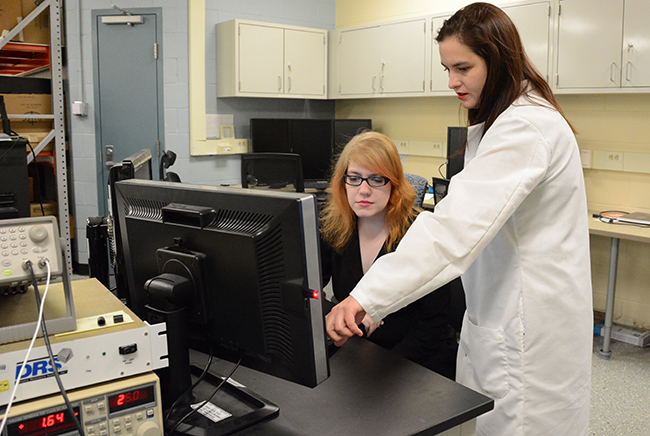
Air Force Research Laboratory Materials and Manufacturing Directorate researchers Megan Imel, left, and Dr. Amanda Criner discuss laboratory test data. Air Force photo by Lori Hughes.
The Air Force plans to appoint a new chief technology officer to direct the $2.8 billion science and technology enterprise and consider which future tech areas would benefit the service the most.
Air Force Secretary Heather Wilson said Wednesday she signed an implementation memo so a “design agent” within the acquisition branch can start planning what the CTO’s responsibilities would be, whether that person will be uniformed or civilian, and where within the service he or she would sit.
The Air Force already has CTOs, including Frank Konieczny, a senior executive within the information dominance branch who has held the position for nearly a decade, and Paul Antonik, acting CTO for the Air Force Research Laboratory.
Wilson said Konieczny focuses more on the cyber realm than on S&T more broadly. The design agent would decide how establishing a high-level CTO could affect similar jobs at AFRL.
According to the Air Force’s Science and Technology 2030 strategy report released this week, a high-level CTO within the service’s headquarters would develop the scientific workforce and oversee research community outreach, lead strategic planning, collaborate with major commands and the acquisition enterprise, and manage the S&T portfolio with direct oversight of AFRL.
“No senior individual has primary responsibility for Air Force science and technology,” the report said. “The heads of Air Force major commands outrank and overrule the most senior scientific and technical leaders, shifting the focus of scientific and technical resources toward nearer-term priorities.”
But Congress may have to sign off on the new position at a time when some lawmakers are concerned about a growing defense bureaucracy. The Pentagon also wants Congress to approve a Space Force, as well as a slew of leaders that would run the new service and the fledgling US Space Command.
The Air Force doesn’t have a set date for when a CTO, who would bring experience from inside and outside government, might be appointed.
Each of the services already employs some version of a CTO. One expert believes the role can help the military keep up with the evolution of information technology, as the services adapt acquisition to the digital age.
“Information technology is changing at a rapid pace, far faster than bureaucracies can respond,” Paul Scharre, director of the Center for a New American Security’s Technology and National Security Program, said. “The military services will need to adopt new approaches to be able to rapidly ‘spin in’ information technology and adapt their operations. You can’t buy software the same way you buy a tank or an aircraft carrier.”
The recommendation for a CTO as a “coherent, strong voice for science and technology” is one of three objectives that resulted from the S&T 2030 effort launched by Wilson in September 2017.
Rather than list off the same advanced technologies the military has pursued for decades—like autonomy, directed energy, and hypersonics—the Air Force tried this time to outline what it wants to achieve and then let industry fill in the details. In doing so, it mirrors the National Defense Strategy by focusing on speed, resilience, complexity, and unblinking global awareness.
The strategy’s three objectives aim to “develop and deliver transformational strategic capabilities,” “reform the way science and technology is led and managed,” and “deepen and expand the scientific and technical enterprise,” according to the report.
“The globalization of technology now allows potential adversaries access to cutting-edge science and technology research and the best science and technology talent,” the Air Force said. “As they work toward reaching technological parity, they also push to erode our military’s technological superiority.”
To combat that, the Air Force wants to bring together experts from each research stage for prototyping and experimentation projects known as “vanguards.” The report does not say on which technologies those vanguards will focus, but the intent is to move programs through development more easily.
The CTO would help choose and guide the vanguards, which could transition to full-fledged acquisition programs or remain as science experiments to see how pieces of different systems work together.
Richard Joseph, the Air Force’s chief scientist, told Air Force Magazine in an interview Monday the service wants to put more money into earlier-stage research experiments that focus on refining system subcomponents.
These changes aim to make AFRL more forward-looking in addition to meeting the major commands’ needs.
“It pulls the researchers away from why they’re there, and the ones who want to do the research wind up, if they can’t accept this, [they] leave,” Joseph said. “How do we recruit and retain the best technical people and how do we get things done for the MAJCOMs? And we’re wrestling with that now.”
The strategy also envisions a closer relationship between the S&T enterprise and the Air Force Warfighting Integration Capability, the recently established cross-functional planning group.
“AFWIC will establish a senior scientist position and assign additional scientists and engineers on a rotating basis to advise in future-force design efforts,” the report said. “Likewise, AFWIC will participate in technology prototyping and experimentation events to provide practical feedback on emerging technologies and operational concepts.”
Wilson has touted S&T 2030 as a potential overhaul of how the Air Force manages that part of its workforce, as well as how it partners with academia and other untapped research entities. The service plans to tap into more university and international talent, grow internships, grants, and student programs, and improve partnerships within the government. It will also devote more attention to keeping the people it has.
“Within the past month … we’ve created a Ph.D. management office in the Air Force headquarters, in the personnel office,” Wilson added. “That requires more care and attention in the stewardship of your career as we manage the talent than we’ve done heretofore. … We can’t afford to lose that talent.”